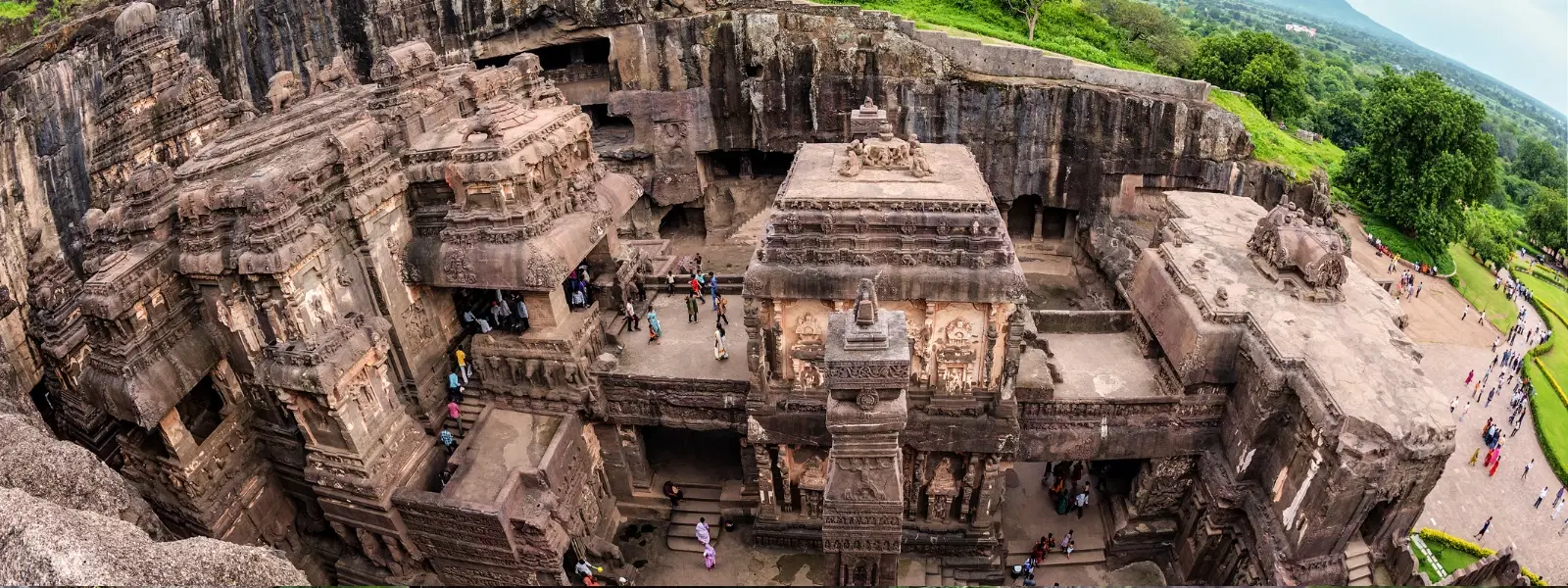
Flights
•04 min read

India's rock-cut temples are a spectacular fusion of nature and human genius, carved directly out of solid stone and echoing tales of ancient civilizations. These mesmerizing wonders not only showcase the mastery of ancient Indian temple architecture but also stand as enduring symbols of rich cultural heritage. This blog post serves as your comprehensive checklist of 10 must-visit rock-cut temples in India, where you will discover their origins, unique features, and the awe they instill in every visitor.
Rock-cut temples are monuments carved directly from hillsides and rock formations, rather than built with separate materials. Unlike traditional structures that are constructed, these stone-cut monuments are hewn directly from natural rock, making them marvels of craftsmanship and engineering. They serve as exemplary representations of ancient Indian temples, showcasing intricate designs and deep spiritual symbolism.
The evolution of rock-cut architecture in India spans centuries, influenced by Buddhist, Hindu, and Jain traditions. The earliest examples emerged during the Maurya period and were further refined during key periods like the Gupta period and under the patronage of the Pallava dynasty. This historical progression illustrates the rise of stone-carved architecture as a powerful medium for expressing religious devotion and artistic innovation.
Nestled in the hills of Maharashtra, the Ajanta Caves are a cluster of Buddhist rock-cut stupas and monasteries that have earned UNESCO World Heritage status. Renowned for their intricate paintings and sculptures depicting Jataka tales, these ancient monuments offer a breathtaking insight into Buddhist art and architectural ingenuity.
A marvel of multi-religious heritage, the Ellora Caves comprise Buddhist, Hindu, and Jain monuments. Among its gems, the Kailasa Temple stands out as the largest monolithic rock-cut temple in the world, exemplifying the pinnacle of stone-carved architecture and spiritual dedication.
The Elephanta Caves are famous for their Hindu rock-cut shrines, predominantly dedicated to Lord Shiva. The iconic Trimurti sculpture, a majestic three-headed representation of Shiva, continues to captivate visitors and art historians alike.
Badami Cave Temples showcase a unique blend of Hindu and Jain rock-carved architecture. The intricate carvings of deities like Vishnu and Shiva, set against the stunning backdrop of rugged cliffs, highlight the excellence of ancient stone workmanship.
These caves, with their significant Jain heritage, offer an intimate glimpse into ancient Indian life through detailed inscriptions and carvings. Udayagiri and Khandagiri are invaluable for those exploring the historical evolution of Indian cave temples.

This temple, dating back to the Pallava era, is celebrated for its rock-cut architecture depicting the Varaha avatar of Vishnu. The detailed reliefs and sculptures make it a must-see for connoisseurs of stone-cut monuments.
Hidden amidst the scenic Dhauladhar range, the Masroor Rock-Cut Temple is a lesser-known Hindu masterpiece. Its isolation and unique location add to its charm, making it a perfect destination for travelers seeking tranquility and heritage.
Located in Mahabalipuram, the Pancha Rathas are a group of monolithic rock-cut structures that embody the drills of Dravidian architectural style. Their inclusion as UNESCO rock-cut temples underscores their cultural significance and enduring allure.
Amarnath Cave Temple holds immense spiritual importance as a revered Hindu pilgrimage site. The natural ice Shiva Lingam formation inside the cave creates a mystic ambiance that attracts devotees and travelers from all over the world.
These Gupta-era Hindu rock-cut shrines are notable for their exquisite carvings, including the prominent Varaha panel. Standing as a testament to the artistic finesse of ancient Indian temple architecture, Udayagiri Caves captivate every visitor with their historic charm.
The creation of these stone-cut monuments involved exceptional craftsmanship and precision. Ancient sculptors used rudimentary tools to chisel away tons of rock, overcoming physical challenges to create intricate reliefs and structures that have withstood the passage of time.
Beyond their architectural brilliance, these temples are adorned with stunning carvings, sculptures, and paintings that reflect the religious and cultural ethos of their times. They provide a narrative of ancient traditions, spiritual allegories, and the socio-cultural dynamics of their eras, making them invaluable historical documents.

Several rock-cut temples in India, including the Ajanta, Ellora, and Pancha Rathas, have been recognized as UNESCO World Heritage Sites. This prestigious acknowledgment is reserved for sites that exhibit exceptional historical, cultural, and architectural value on a global scale.
Indian rock-cut temples have not only defined the architectural landscape of the subcontinent but also inspired similar structural marvels worldwide. Their innovative techniques and aesthetic appeal continue to influence modern architecture and cultural preservation efforts globally.
Did you know? The Kailasa Temple at Ellora is carved out of a single rock and is considered one of the largest monolithic structures in the world. It is estimated that over 200,000 tons of rock were removed to create this architectural wonder!
India is home to hundreds of rock-cut temples, with notable ones located in Maharashtra, Tamil Nadu, Karnataka, and Odisha.
The largest rock-cut temple in India is the Kailasa Temple at Ellora Caves in Maharashtra.
The Ajanta Caves in Maharashtra house several rock-cut stupas, which are significant in Buddhist architecture.
Examples include the Ajanta and Ellora Caves, Elephanta Caves, and the Pancha Rathas in Mahabalipuram.
Rock-cut architecture in India was pioneered by Buddhist monks during the Maurya period, around the 3rd century BCE.
India's rock-cut temples are more than ancient stone structures; they are timeless testaments to the ingenuity and devotion of past civilizations. From the sublime artistry at Ajanta and Ellora to the secluded beauty of Masroor and Amarnath, each site invites you on a journey through history, art, and spirituality. Whether you are the wanderer in search of affordable adventures, the planner organizing a family retreat, or the professional and luxury seeker desiring well-crafted cultural experiences, these temples offer an unforgettable exploration of ancient Indian tradition and craftsmanship.